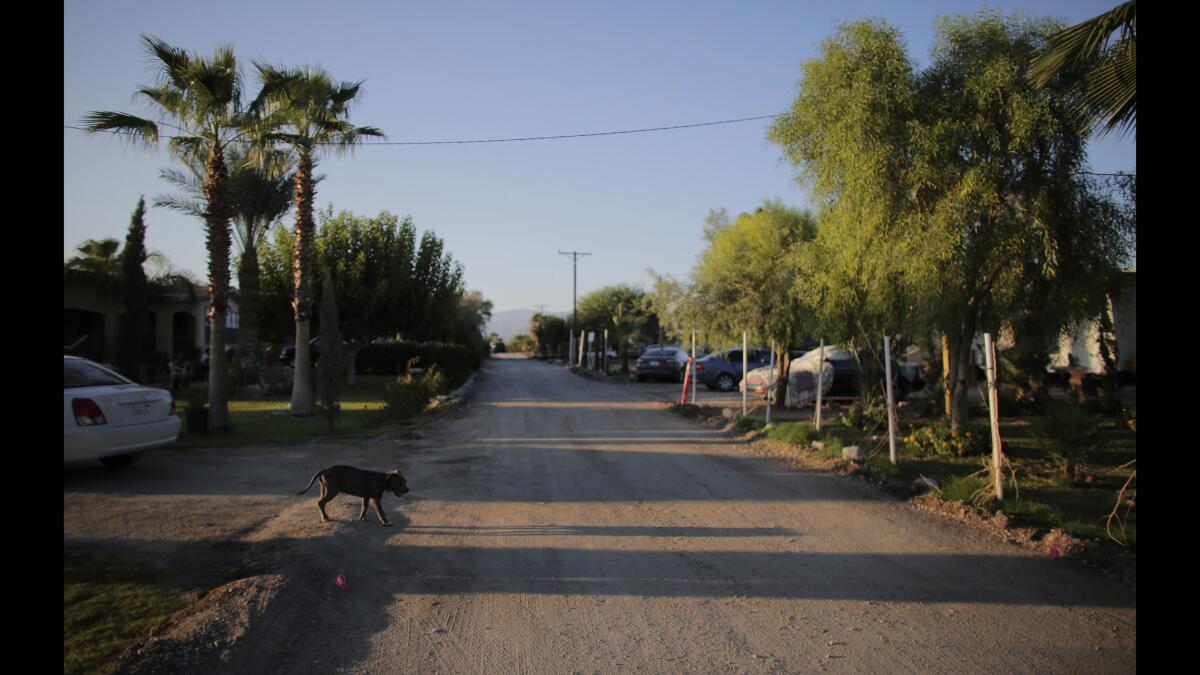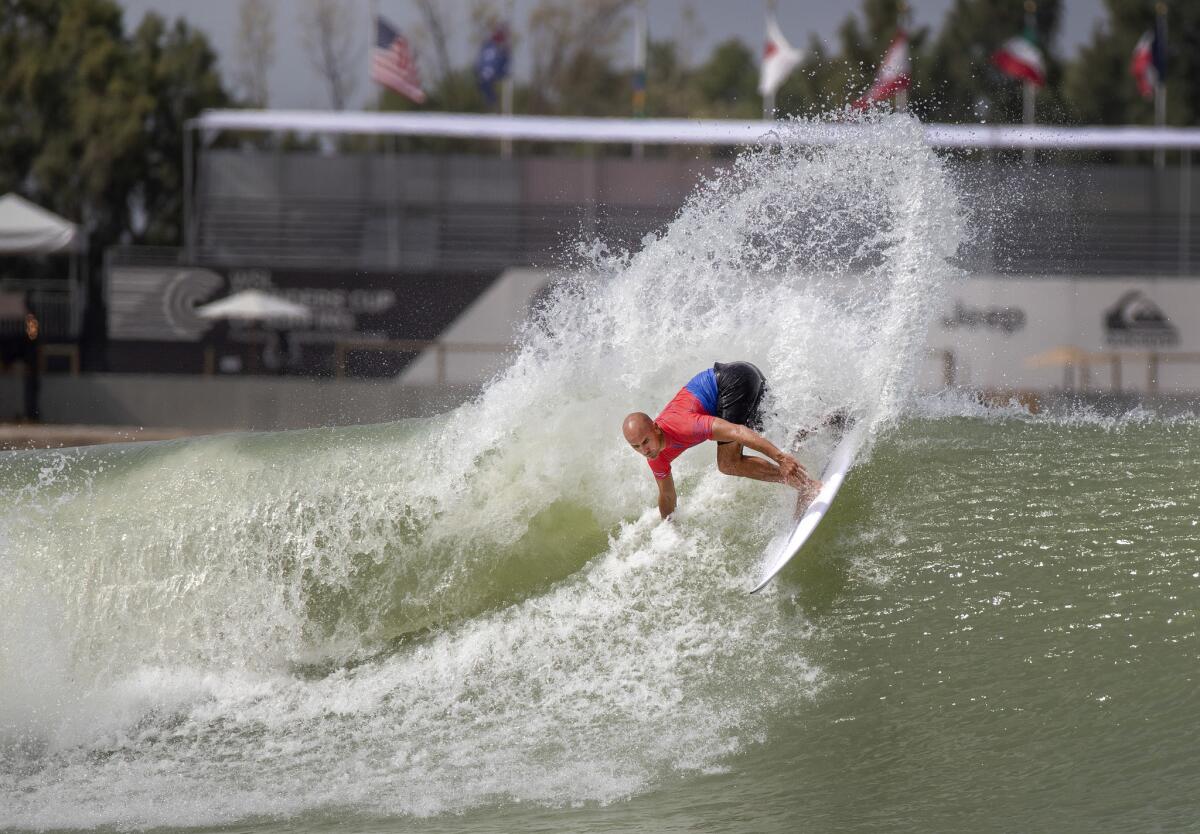Plans for a luxury surf resort in an impoverished desert community spark inequity battle

- Share via
In the driest reaches of the California desert, a fight is brewing over a proposed luxury surf resort that would rise in a deeply impoverished part of the eastern Coachella Valley.
The proposed Thermal Beach Club is being billed as a first-of-its-kind destination, where a 22-acre surf lagoon with ocean-simulating waves would anchor a development with hundreds of high-end private residences and fancy clubhouse amenities. It would be the kind of place where, according to environmental planning documents, residents would be picked up by staff-driven golf carts and dropped off at the amenity of their choosing.
The development would take shape on what is now vacant land in Thermal, an unincorporated community in Riverside County about a dozen miles from the edge of the Salton Sea.
But to call the proposed Thermal oasis incongruous with the existing surroundings would be an understatement of comic proportions, and the plans have drawn fierce opposition from local community activists.
Thermal is a predominantly Latino community where more than a third of residents live below the poverty line, according to census data. The median household income is about $27,455.
It’s also an area of the desert that, according to the Desert Sun of Palm Springs, is “increasingly being eyed by developers as a place for profit-driven projects instead of the affordable housing and environmental justice measures that residents say are needed.”
The area is already home to the members-only Thermal Club, a recently completed motorsports development where multimillion-dollar villas surround four racetracks, with a staff of racing professionals on hand. The Times has described the Thermal Club as “an alternative playground for the ultra-rich,” where one member, for example, keeps 87 cars on site.
Lesly Figueroa, a policy advocate with Leadership Council for Justice and Accountability who organizes with communities in the eastern Coachella Valley, described “the big walls” that surround the ultra-exclusive motorsports club. She said some folks don’t even know what’s inside. They just hear the noise, and see the walls “that are meant to separate that community from the rest of the eastern Coachella Valley.”
“Yes, development does need to happen. But it also needs to be equitable,” Figueroa said. She and other activists want to ensure that the powers that be are planning for the community that already lives here, rather than just the future vacationers and second-home owners. In her view, the biggest message that residents have for local officials is simple: Don’t rush the Thermal Beach Club, and take our voices into account.
Of course, one has to understand the eastern Coachella Valley — and the stark contradictions of the broader valley in which it resides — in order to really understand the controversy over Thermal Beach Club.
To outsiders, the name Coachella is often synonymous with big-name musical acts and a flower crown-clad crowd of lithe young things — the trappings of the music festival that draws hundreds of thousands to the Indio polo grounds every year. The western part of the valley is home to large pockets of concentrated wealth, like the resort towns of Rancho Mirage and Indian Wells.
“For folks who live in the eastern part of the valley, there’s just a lot less resources, a lot less investment — a lot less of everything,” Figueroa explains. Thermal is one in a cluster of several small unincorporated communities nearby.
“There’s not a lot of water and wastewater infrastructure that goes into the communities. A lot of people are low-income, Latino, farmworkers,” Figueroa said, naming populations that are historically marginalized and often likely to be underserved.
The eastern Coachella Valley is also a place where critics say environmental racism abounds,
Toxic fumes from a nearly monthlong mulch fire at a recycling center recently closed local schools for days and triggered respiratory illnesses, though few local farmworkers received a respite from their work in the fields.
The shrinking Salton Sea produces clouds of salty, alkaline toxic dust containing heavy metals, agricultural chemicals and powdery-fine particulates linked to asthma, respiratory diseases and cancer, affecting the health of area residents. Nearby agricultural fields can also bring pesticide exposure.
But the ground for this desert fight was actually laid in another rural California farm community several hundred miles away.
A half-decade ago, the world’s greatest surfer bought a man-made lake specially built for water skiing amid the alfalfa fields of Lemoore.
It was there, in the Central Valley town just south of Fresno, that Kelly Slater partnered with a USC professor to construct an engineering marvel of an artificial wave pool that could alter the future of competitive surfing.
Artificial wave systems had long existed, but they were largely of the dinky, recreational variety, limited to the province of suburban water parks and screaming kids. All of that changed with Slater’s Surf Ranch, which brought wave pools cresting toward their own broader cultural moment.

The next year, Slater released the first video from his mystery-cloaked testing site. It showed the legend riding a perfect multifoot wave more than a hundred miles inland from the Pacific Ocean and shook the surfing world.
The release of that 2015 video “opened up this idea that wave pools could now be performance-based, as opposed to a gimmick,” according to Will McFarland, a marketing manager at American Wave Machines.
The Solana Beach-based company, which developed its own wave pool system called PerfectSwell, already powers a surf resort in Waco, Texas, and would be the provider for the proposed Thermal Beach Club.
“The demand for surf is beyond your wildest imagination,” said McFarland. “And I say that without any hyperbole whatsoever.”
There is, in his view, a scarcity of waves in California. Even under the most favored of circumstances, when the ocean gods shine down and bring sweet swell, there is still the mass of other barrel-chasing bodies to contend with. Which means that the best surf spots are often too crowded to even catch a wave.
That’s what makes the waves-on-demand market so alluring to a company like his. And the Thermal Beach Club, it should be noted, is just one of several surf pool attractions that are currently in the works in the greater Palm Springs area. The upside is huge.
Planning documents say that the proposed surf lagoon would be capable of producing six waves per second with maximum heights of seven feet and the technology to ensure that the water will “remain crystal clear and blue at all times.”
That crystal-clear water would stand in stark contrast to what comes out of the taps at the nearby Oasis Mobile Home Park, where the the U.S. Environmental Protection Agency has found arsenic contamination at up to 10 times the allowable limit. According to the Desert Sun, many of the trailer park’s 1,900 inhabitants are undocumented farmworkers, some of whom only speak the indigenous language of Purepecha.
Figueroa and fellow advocates started doing door-to-door outreach when they first about the Thermal Beach Club proposal in late September. “Traditionally, how the planning process has worked [is that] it doesn’t include the community,” she said. “It’s a developer-to-agency relationship.” But Figueroa, who is a Coachella native herself, wanted to ensure that the community played a role in this planning process.
The conflicts came to a head this past Tuesday when the Riverside County Board of Supervisors — which will need to grant rezoning and environmental approvals for the project — decided to delay their vote on the matter amid angry testimony from community members.
The board is likely to take the vote up again in December. For activists like Figueroa the situation isn’t unique, just “the last straw” for “something that’s been brewing for a while within the eastern Coachella Valley.”
“We can’t keep making land use decisions and housing decisions like this,” she said. “The traditional planning process needs to be different.”
More to Read
Sign up for Essential California
The most important California stories and recommendations in your inbox every morning.
You may occasionally receive promotional content from the Los Angeles Times.











